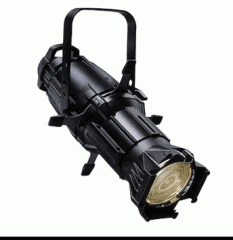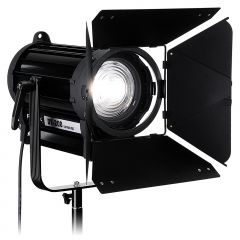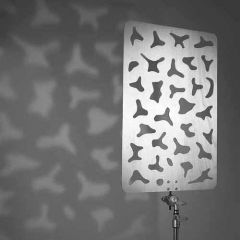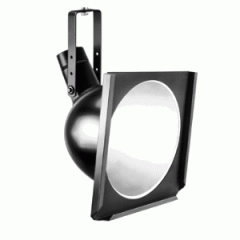![]()
![]()
![]()
Use LEFT and RIGHT arrow keys to navigate between flashcards;
Use UP and DOWN arrow keys to flip the card;
H to show hint;
A reads text to speech;
82 Cards in this Set
- Front
- Back
|
Background Light
|
General lighting on the set behind the talent.
|
|
|
Back Light
|
A highly directional light coming from above and behind a subject, adding highlights, shape, and separation from the background.
|
|
|
Barn Doors
|
Movable metal shutters attached to the front of a lighting instrument used to limit the area of the projected light.
|
|
|
Base Light
|
The overall illumination of an image, based on the minimum amount of light needed for a camera to operate.
|
|
|
Batten
|
A lightweight metal or plastic pipe that can be attached to others using joiners and supporting mechanisms to create a grid on which lights can be hung; some battens and grids can be lowered to allow lights to be hung and adjusted at floor level before being raised back up to the ceiling.
|
|
|
Broad
|
A rectangular floodlight.
|
|
|
Cameo Lighting
|
A type of lighting where the performer is lit but the background is not. |
|
|
Catwalk |
A structure above or around a lighting grid on which technicians can crawl to position lights. |
|
|
C-clamp |
A metal clamp with a pivot adjustment for attaching lighting instruments to a lighting grid. |
|
|
C-stand |
A c-shaped mounting used to place a flag-sized piece of material in front of a light to achieve a particular visual effect. |
|
|
Chroma Key
|
A special effect in which a designated color (usually green or blue) is used as a key to determine what picture information is to be cut out of the picture with the foreground image.
|
|
|
Color Temperature
|
The relative reddish or bluish quality of a light source, as measured in degrees Kelvin.
|
|
|
Contrast Ratio
|
The relationship of the brightest area to the darkest area in a given camera shot, as determined by reflected light readings.
|
|
|
Cookie
|
A metal or wooden cutout pattern that is placed in front of a spotlight to produce a shadow effect on a scenic background.
|
|
|
Creative Light
|
Lighting that enhances the mood, style, and perspective of an object or scene and that can reveal shape and focus attention.
|
|
|
Cross-keying
|
A lighting technique that uses one light for several purposes, such as a key light and a backlight.
|
|
|
Cucalorus |
A metal or wooden cutout pattern that is placed in front of a spotlight to produce a shadow effect on a scenic background. |
|
|
Cyclorama |
A large, continuous, smooth backing, usually made of cloth, that may cover two or three walls of a studio. |
|
|
Dimmer Board |
A lighting control unit, operated on the same principle as a rheostat, that determines the intensity of a light by controlling the amount of electric current flowing to the instrument. |
|
|
Dimmer Circuit |
One fader of a dimmer board that brings up one or several lights. |
|
|
Director of Photography |
A lighting director who commonly works in field production. |
|
|
DMX
|
A popular lighting control protocol used with a dimmer board.
|
|
|
Ellipsoidal
|
A spotlight with a reflecting mirror at the back of the housing that enables it to create a very directional, well-defined beam.
|
|
|
Ellipsoidal |

|
|
|
Fader Bar |
A handle unit on a video switcher that allows the operator to change manually from one bus to another. |
|
|
Fill Light |
An unfocused and diffused light used to complement the key light, coming from the side opposite the key to fill in dark areas and soften shadows. |
|
|
Flag |
A rectangular cloth-covered or metal frame placed in front of a lighting instrument to produce a precise shadow on one side of the light beam. |
|
|
Flat Lighting |
A general lighting throughout a set that does not create many shadows. |
|
|
Floodlight |
A lamp fixture that creates diffused light covering a wide area. |
|
|
Floor Stand |
A stand that holds a light.
|
|
|
Follow Spot |
A light of high intensity that is most commonly used to follow a performer as he or she moves around a stage area. |
|
|
Foot-candle |
A unit of light measurement equivalent to the amount of light falling upon a surface one foot away from a standard candle. |
|
|
Fresnel |
A light with a well-defined lens; the beam width is varied as the bulb is moved toward or away from the lens. |
|
|
Fresnel
|

|
|
|
Gel |
A thin, translucent, colored material that can be mounted in front of lighting instruments to produce specific color effects. |
|
|
Gobo
|
A patterned metal cutout inserted between the bulb and the end glass of an ellipsoidal light, which casts the pattern onto the set.
|
|
|
Gobo
|

|
|
|
Cookie |

|
|
|
Cucoloris |

|
|
|
High-frequency Fluorescent Lamp |
A low-energy, long-lasting light that puts out reds, greens, and blues in a consistent manner to produce 3,200 K or 5,500 K light that oscillates between 25,000 and 40,000 cycles per second. |
|
|
High-intensity Discharge Lamp
|
A 5,600 K light that is more efficient than tungsten lights.
|
|
|
High-key Lighting
|
Lighting that is generally bright and even, with a low key-to-fill ratio.
|
|
|
High-speed Fluorescent Lamp
|
A low-energy, long-lasting light that puts out reds, greens, and blues in a consistent manner to produce 3,200 K or 5,500 K light that oscillates between 25,000 and 40,000 cycles per second.
|
|
|
HMI
|
A hydrargyrum medium-arc-length iodide lamp that is balanced for daylight and is often used outdoors as a supplement to the light from the sun.
|
|
|
Incident Light
|
Light coming directly from the source of illumination.
|
|
|
Inverse Square Law
|
A principle of physics that states that when the distance between a light (or an audio source) and its point of perception is reduced by half, its intensity will be increased fourfold.
|
|
|
Kelvin
|
The scale of measurement used to measure the frequency of a light wave, which determines its color temperature.
|
|
|
Key Light
|
The primary source of illumination falling on a subject that is highly directional and produces a definite modeling or shaping effect with well-defined shadows.
|
|
|
Kicker
|
Additional light, usually a spotlight, coming from the side and slightly to the rear of the subject.
|
|
|
Kook
|
A metal or wooden cutout pattern that is placed in front of a spotlight to produce a shadow effect on a scenic background.
|
|
|
Light Meter
|
A photoelectric device that measures in foot-candles the amount of light falling on a specific area.
|
|
|
Light Plot
|
A floor plan that indicates the lighting requirements— location, type, and function of each instrument— for every staging area in the studio.
|
|
|
Light Emitting Diode
|
An electron tube that puts out light. Series of LEDs may be used as indicators of sound volume.
|
|
|
Lighting Director
|
The person who oversees the lighting of the set and makes lighting changes, if they are needed, during production.
|
|
|
Limbo Lighting
|
A type of lighting where the performer is seen clearly, but the background appears to be vague or nondescript.
|
|
|
Low-key Lighting
|
Lighting that is dark and shadowy with a high key-to-fill ratio.
|
|
|
Non-dimmer Circuit
|
A switch that turns a light off and on but cannot adjust its brightness.
|
|
|
Open-face Spot
|
A light housing that is generally round but does not have a lens on the front.
|
|
|
Pan
|
A rectangular floodlight.
|
|
|
Patch Bay
|
A board with numerous terminals (inputs and outputs) through which various audio, video, or lighting signals can be connected by patch cords to other channels or circuits.
|
|
|
Patch Board
|
A board with numerous terminals (inputs and outputs) through which various audio, video, or lighting signals can be connected by patch cords to other channels or circuits.
|
|
|
Pinned
|
Describes rays of a spotlight focused into a narrow beam of intense light.
|
|
|
Quartz Lamp
|
A lamp with a tungsten filament and halogen gas in a quartz or silica housing.
|
|
|
Quartz-halogen Lamp
|
A lamp with a tungsten filament and halogen gas in a quartz or silica housing.
|
|
|
Reflected Light
|
Light bounced back from the surface of an object.
|
|
|
Safety Chain
|
A steel chain on a lamp housing that should always be attached to the lighting grid so that the housing will not fall if it comes loose from its mounting.
|
|
|
Scoop
|
A floodlight that contains a single bulb in a bowl shaped metal reflector.
|
|
|
Scoop
|

|
|
|
Scrim
|
A translucent filter, often made of fiberglass or fine screening, used in front of either a spotlight or a floodlight to soften and diffuse the light quality.
|
|
|
Set Light
|
General lighting on the scenery or other background behind the talent.
|
|
|
Silhouette Effect
|
A type of lighting where the background is lit but the performers are not.
|
|
|
Snoot
|
A circular metal object placed in front of a light to pinpoint the light onto a particular area of the set.
|
|
|
Softlight
|
A lamp that has the bulb positioned in such a way that the light is reflected on the back of the lamp housing before leaving the fixture.
|
|
|
Spotlight
|
A concentrated light that covers a narrow area; it usually provides some means for varying the angle of the illumination by moving the bulb within the housing.
|
|
|
Spot Meter
|
A type of light meter that measures the amount of reflected light coming from a small, specific area.
|
|
|
Spread
|
To focus the rays of a Fresnel spotlight to a relatively wide area so that the light is less intense than when the light is in the pinned position.
|
|
|
Strip Lights
|
A series of pan lights or low-wattage bulbs mounted in a row of three to 12 lights in one housing, used as a specialized floodlight for lighting a cyclorama or other large background area.
|
|
|
Three-point Lighting
|
The traditional lighting setup that incorporates a key, a fill, and a backlight.
|
|
|
Triangular Lighting
|
The traditional lighting setup that incorporates a key, a fill, and a backlight.
|
|
|
Trim
|
To make final adjustments on lights.
|
|
|
Tungsten-halogen Lamp
|
A lamp with a tungsten filament and halogen gas in a quartz or silica housing.
|
|
|
Variable Spotlight
|
A light housing that is generally round but does not have a lens on the front.
|

